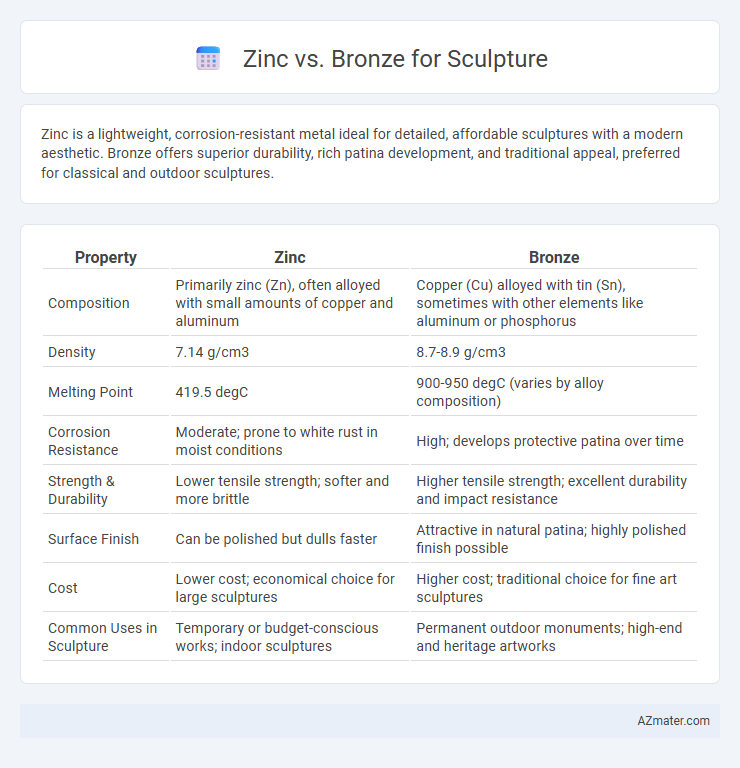Zinc is a lightweight, corrosion-resistant metal ideal for detailed, affordable sculptures with a modern aesthetic. Bronze offers superior durability, rich patina development, and traditional appeal, preferred for classical and outdoor sculptures.
Table of Comparison
| Property | Zinc | Bronze |
|---|---|---|
| Composition | Primarily zinc (Zn), often alloyed with small amounts of copper and aluminum | Copper (Cu) alloyed with tin (Sn), sometimes with other elements like aluminum or phosphorus |
| Density | 7.14 g/cm3 | 8.7-8.9 g/cm3 |
| Melting Point | 419.5 degC | 900-950 degC (varies by alloy composition) |
| Corrosion Resistance | Moderate; prone to white rust in moist conditions | High; develops protective patina over time |
| Strength & Durability | Lower tensile strength; softer and more brittle | Higher tensile strength; excellent durability and impact resistance |
| Surface Finish | Can be polished but dulls faster | Attractive in natural patina; highly polished finish possible |
| Cost | Lower cost; economical choice for large sculptures | Higher cost; traditional choice for fine art sculptures |
| Common Uses in Sculpture | Temporary or budget-conscious works; indoor sculptures | Permanent outdoor monuments; high-end and heritage artworks |
Introduction to Zinc and Bronze in Sculpture
Zinc and bronze are prominent metals used in sculpture, each possessing distinct properties that influence artistic choices. Zinc, a lightweight and corrosion-resistant metal, offers versatility and a bright, silvery appearance ideal for contemporary artworks. Bronze, an alloy of copper and tin, has been favored for centuries due to its durability, warm patina, and ability to capture fine details in sculpture.
Historical Use of Zinc and Bronze in Art
Zinc and bronze have distinct historical significance in sculpture, with bronze being favored since ancient times for its durability and rich patina in classical and Renaissance art. Zinc gained popularity in the 19th century as a cost-effective alternative, often used for statues, architectural ornaments, and garden sculptures during the Victorian era. Bronze's alloy composition of copper and tin creates a stronger, more weather-resistant medium, whereas zinc's corrosion resistance provides a lighter, more malleable option for intricate detailing in decorative art.
Material Properties: Zinc vs Bronze
Zinc offers a lightweight and corrosion-resistant material ideal for outdoor sculptures, with a lower melting point and greater malleability compared to bronze, facilitating detailed casting. Bronze, composed primarily of copper and tin, provides superior strength, durability, and a classic warm patina that develops over time, making it favored for long-lasting, high-detail artworks. Both metals exhibit excellent weather resistance, but bronze's hardness and traditional aesthetic often make it the preferred choice for monumental sculptures.
Aesthetic Differences in Finished Sculptures
Zinc sculptures typically exhibit a smooth, silvery-gray finish that can develop a natural bluish patina over time, offering a sleek and contemporary aesthetic. Bronze sculptures possess a rich, warm brownish-gold tone that deepens with oxidation, creating a classic and timeless appearance favored in traditional art. The contrasting surface textures and aging processes of zinc and bronze impact the visual depth and character, influencing the overall aesthetic impression of the finished sculpture.
Durability and Longevity Comparison
Zinc sculptures offer moderate durability with resistance to corrosion but tend to be more brittle and prone to cracking over time compared to bronze. Bronze alloys, primarily composed of copper and tin, exhibit superior strength and exceptional longevity, often lasting centuries with minimal degradation. The patina formed on bronze also provides a protective layer, enhancing its resilience against weathering and environmental damage, making it the preferred choice for long-term outdoor sculptures.
Workability for Sculptors: Casting and Shaping
Zinc offers superior malleability and is easier to cast, allowing sculptors to achieve intricate details with less effort compared to bronze. Bronze, composed primarily of copper and tin, provides greater strength and durability but requires higher temperatures for casting and more precise control during shaping. Sculptors favor bronze for its longevity in outdoor installations, while zinc is often chosen for experimental or smaller-scale works due to its workability and cost-effectiveness.
Cost and Availability of Zinc and Bronze
Zinc is generally more affordable than bronze, making it a cost-effective choice for sculpture production, especially for larger works or budget-conscious projects. Bronze, an alloy primarily composed of copper and tin, tends to be more expensive due to the higher cost of raw materials and the traditional demand in fine art casting. While zinc is widely available and easier to source in large quantities, bronze availability can be more limited and subject to market fluctuations in metal prices.
Environmental Impact and Sustainability
Zinc sculptures have a lower environmental impact due to their recyclability and energy-efficient production compared to bronze, which requires extensive mining and smelting of copper and tin, leading to higher carbon emissions. Zinc's lightweight properties reduce transportation emissions, while bronze's durability often outlasts zinc, impacting long-term sustainability considerations. Choosing zinc may support greener practices in sculptural art, though bronze remains valued for its heritage and resilience.
Notable Sculptures: Zinc vs Bronze
Bronze has been the material of choice for iconic sculptures such as Auguste Rodin's "The Thinker" and the Statue of Liberty, prized for its durability and rich patina that enhances artistic detail. Zinc, utilized in notable works like the architectural sculptures of the 19th century, offers a lightweight and cost-effective alternative but is less enduring and prone to corrosion over time. The selection between zinc and bronze significantly influences the longevity, texture, and aesthetic value of sculptures in public and private art collections.
Choosing the Right Material for Your Sculpture
Zinc offers a lightweight, corrosion-resistant option for outdoor sculptures, providing a sleek metallic finish that patinas over time, while bronze is favored for its durability, strength, and classic warm tones ideal for detailed, long-lasting masterpieces. Bronze's higher density and tensile strength make it suitable for intricate designs and larger-scale sculptures exposed to varying weather conditions. Prioritize bronze for traditional, enduring artworks and zinc when budget, weight, and modern aesthetics are key factors in your sculpture project.

Infographic: Zinc vs Bronze for Sculpture
 azmater.com
azmater.com